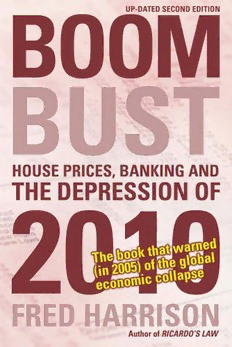
Boom-bust: house prices, banking and the depression of 2010 PDF
Preview Boom-bust: house prices, banking and the depression of 2010
Boom Bust 7/1/10 11:19 Page i Boom Bust Boom Bust 7/1/10 11:19 Page ii Boom Bust 7/1/10 11:19 Page iii Boom Bust HOUSE PRICES, BANKING AND THE DEPRESSION OF 2010 Fred Harrison SHEPHEARD-WALWYN (PUBLISHERS) LTD Boom Bust 7/1/10 11:19 Page iv © Fred Harrison 2005 All rights reserved. No part of this book may be reproduced in any form without the written permission of the publisher, Shepheard-Walwyn (Publishers) Ltd First published in 2005 by Shepheard-Walwyn (Publishers) Ltd 107 Parkway House, Sheen Lane London SW14 8LS Reprinted 2005 Paperback reprint 2007 2nd edition November 2007 2nd up-dated edition January 2010 British Library Cataloguing in Publication Data A catalogue record of this book is available from the British Library ISBN-13: 978-0-85683-254-3 ISBN-10: 0-85683-254-5 Typeset by Alacrity, Chesterfield, Sandford, Somerset Printed and bound through s|s|media limited, Wallington, Surrey Boom Bust 7/1/10 11:19 Page v Contents Acknowledgements vii Preface to the Second Edition ix Prologue xi PART I AS SAFE AS HOUSES? 1 Britain’s Housing and the Business Cycle 3 2 Banking on Failure 21 3 The American State of Virtual Reality 38 4 The Incredible Alan Greenspan 54 PART II GENESIS OF THE BOOM-BUST CYCLE 5 Rent and the 18-Year Cycle 73 6 The Patterns of History 100 7 The Alchemy of Land Speculation 119 8 The End of Boom Bust? 135 PART III ANATOMY OF THE FIRST GLOBAL CYCLE 9 The New Economy: Selling an Anglo-American Myth 155 10 Launched in the USA 168 11 Gordon Brown’s Magic Mantra 185 v Boom Bust 7/1/10 11:19 Page vi PART IV THE AUTOMATIC STABILISER 12 Counter-Cyclical Action 207 13 Australia: The Pathology of Taxation 226 14 Dividends from Democratised Finance 246 PART V THE RECKONING 15 2007: From Peak to Downwave 265 16 2010: Economics of the Debt Junkie 274 Index 282 vi Boom Bust 7/1/10 11:19 Page vii Acknowledgements IT IS WITH PLEASURE that I take this opportunity to thank those who helped me to bring Boom Bust to fruition. In particular, my gratitude is extended to Mason Gaffney and Ron Banks for their wise counsel over the years; Ed. Dodson (USA) and Bryan Kavanagh (Australia) who generously shared with me the results of research in their countries; and Don Riley for stepping in with material support at a time when I most needed it. My publisher Anthony Werner has been a relentless source of constructive criticisms, and Anne Morrell bore with fortitude the tedium of correcting what seemed like an endless stream of revisions. No words, however, can adequately express the debt I owe to my wife, Rita, whose moral support and editing skills were indispensable in bringing this volume to a conclusion. vii Boom Bust 7/1/10 11:19 Page viii To Rita Boom Bust 7/1/10 11:19 Page ix Preface to the Second Edition WHY, THE Queen of England wanted to know when she visited one of her pre-eminent schools of learning, hadn’t anyone seen the financial crisis coming? No-one saw it coming, replied Professor Luis Garicano of the London School of Economics, because ‘At every stage, someone was relying on some- body else and everyone thought they were doing the right thing’. Some people had seen it coming. My first warning was published in 1997, in The Chaos Makers, a thesis elaborated in 2005 in this book. I specified when the business cycle would come to an end, the causes that would terminate growth and employment, and the severity of the crash. Now we are being assured that it is not going to happen again. The presidents and prime ministers of the G20 countries who met in Pittsburgh in September 2009, promised a future of ‘balanced growth’. The surreal terms of their communiqué mean that the next land market-led boom will end in 2026 with an even more painful bust. Governments are restoring the status quo: there will be no change to the rules that cause the economy to break down, time and again, like clockwork. That, of course, is not the authorised version of the political response to the crises. When Barack Obama arrived in Washington as President, in January 2009, hopes were raised that, this time, there would be change – Obama’s election campaign mantra. The adminis- tration would prevent the US tipping into a depression. Obama adopted a $787bn fiscal stimulus plan, as Larry Summers, director of the White House National Economic Council, warned that the US was locked into the worst downturn since the Great Depression. UK output fell by more than 5% in 2009 – a crash in pro- duction last seen in the 1930s. Commentators openly acknowledged that Ireland and Spain were in depression. But, otherwise (claimed the forecasters), for much of Europe there were glimmers of ‘green shoots’ of recovery. When does a recession turn into a depression? A recession is defined as two quarters of negative growth. By the autumn of 2009, ix
